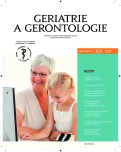Dokážeme včasně diagnostikovat poruchy polykání?
Časný screening poruch polykání, kazuistiky
Authors:
MUDr. Pavlína Malochová; MUDr. Pavla Mádlová; MUDr. Tomáš Richter; Prof. MUDr. Eva Topinková, CSc.
Authors‘ workplace:
Geriatrická klinika 1. LF UK a VFN, Praha
Published in:
Geriatrie a Gerontologie 2013, 2, č. 3: 165-170
Category:
Case Reports
Overview
We present several case studies that illustrate the diversity of aetiology of swallowing disorders and point out the need for early detection of problems. We also present the most commonly used tests for screening and differential diagnosis of dysphagia. In all these cases dysphagia had significant impact on the nutritional status of patients and in most cases led to significant health complications.
Key words:
swallowing disorders – swallowing tests – eating assessment tool EAT-10
Sources
1. Kawashima K, Motohashi Y, Fujishima: Prevalence of dysfagia among community-dwelling elderly individuals as estimated using a questionnaire for dysphagia screening. Dyphagia 2004; 19(4): 266–271.
2. Tedla M, Komínek P, Chrobok V et al.: Poruchy polykání. 1. vyd. Tobiáš, Havlíčkův Brod 2009.
3. Jurašková B, Hrnčiariková D, Holmerová I et al..: Poruchy výživy ve stáří. Medicína pro praxi 2007; 4(11): 443–446. www:solen.cz/pdf/med/2007/11/02.pdf
4. Masiero S, Piebon R, Previato C, Gomero E: Pneumonia in stroke patients with oropharyngeal dysphagia: a six month follow up study. Neurol Sci 2008; 29: 139–145.
5. Karásková L, Škvrňáková J, Mandysová P: Zjišťování subjektivních změn v polykání u seniorů. Geri a gero 2012; 1: 20–23.
6. Belafsky PC, Mouadeb DA, Rees CJ et al.: Validity and reliability of eating assesment tool (EAT-10). Annals of Otology, Rhinology and Laryngology 2008; 117(12): 919–924.
7. Mandysová P, Petržílková K, Škvrňáková J, Karásková L: Subjektivně pociťované potíže s polykáním – využití nástroje EAT-10. Česká a Slovenská neurologie a neurochirurgie 2011; 74(107): 118–119.
8. Daniels SK, Brailey K, Priestly DH et al.: Aspiration in patients with acute stroke. Arch Phys Med Rehabil 1998; 79(1): 14–9.
9. Daniels SK, Ballo LA, Mahoney MC, Foundas AL: Clinical predictors of dysphagia and aspiration risk: outcome measures in acute stroke patients. Arch Phys Rehabil 2000; 81: 1030-1033.
10. Mandysová P, Ehler E, Škvrňáková J a kol.: The development of an eight-item test for nurse-led dysphagia screen. Ošetrovateĺstvo: teória, výskum, vzdelávanie (online) 2012; 2(2): 45–50. www.osetrovatelstvo.eu
11. Trapl M a kol.: Dysphagia Bedside Screening for Acute-stroke Patients. Stroke. Ahajournals. org/content/38/11/2948.full
12. Rosenbeck JC, Robbins J, Roecker EB et al.: Penetration-Aspiration Scale. Dysphagia 1996; 11: 93–8.
13. Logemann JA: Evaluation and Treatment of Swallowing Disorders, second edition, Austin: PROED 1998; 53–54.
14. Onder G, Carpenter I, Finne-Soveri H et al.: Assessment of nursing home residents in Europe: the Services and Health for elderly in Long TERm care ( SHELTER) study, BMC Health Serv Res 2012; 12: 5.
15. Carnaby G, Hankey GJ, Pizzi J.: Behavioral intervention for dysphagia in acute stroke: a randomised controlled trial. Lancet Neurol 2006; 5: 31–37.
16. Logemann JA, Gensler G, Robbins J, et al.: A randomized study of three interventions for aspiration of thin liquids in patiens with dementia or Parkinson’s disease. J Speech Lang Hear Res 2008; 51: 173–183.
17. Groher ME, Crary MA: Dysphagia: clinical management in adults and children. maryland heights. MO: Mosby Elsevier 2010.
18. Kahrilas PJ, Logemann JA, Krugler C, Flanagan E: Volitional augmentation of upper aesophageal sphincter mening during swallowing. AM J Physiol 1991; 260: 450–456.
19. Sura L, Madhavan A, Carnaby G, Crary M: Dysphagia in the elderly: management and nutritional considerations. Clinical Interventions in Aging 2012; 7: 287–298.
20. Carnaby G, Hankey GJ, Pizzi J: Behavioral intervention for dysphagia in acute stroke: a randomised controlled trial. Lancet Neurol 2006; 5: 31–37.
21. Topinková E: Geriatrie pro praxi. Praha, Galén 2005.
22. Shaker R, Easterling C, Kern M et al.: Rehabilitation of swallowing by exercise in tube fed patiens with pharyngeal dysphagia secondary to abnormal UES mening. Gastroenterology 2002; 122: 1314–1321.
23. Shaker R, Kern M, Bardan E et al.: Augmentation of deglutitive upper esophageal sphincter mening in elderly by exercise. AM J Physiol 1997; 272: 1518–1522.
24. Kuo S, Rhodes RL, Mitchell SL et al.: Natural history of feeding-tube use in nursing home residents with advanced dementia. J Am Med Dir Assoc 2009; 10(4): 264–270.
25. Grant MD, Rudberg MA, Brody JA: Gastrostomy placement and mortality among hospitalized Medicare beneficiaries. JAMA 1998; 279: 1973–1976.
26. http://www.americangeriatrics.org/healthcare proffessionals/practice management/choosing wisely
27. Topinková E: Využití standardizovaných škál pro hodnocení stavu výživy u starších nemocných. Čes Geriatr Rev 2003; 11: 6–11.
Labels
Geriatrics General practitioner for adults Orthopaedic prostheticsArticle was published in
Geriatrics and Gerontology

2013 Issue 3
- Metamizole vs. Tramadol in Postoperative Analgesia
- Memantine in Dementia Therapy – Current Findings and Possible Future Applications
- Memantine Eases Daily Life for Patients and Caregivers
- Metamizole at a Glance and in Practice – Effective Non-Opioid Analgesic for All Ages
- Advances in the Treatment of Myasthenia Gravis on the Horizon
Most read in this issue
- The impact of physiotherapy on self-sufficiency of geriatric patients
- The little things in geriatrics – three case reports
-
Dokážeme včasně diagnostikovat poruchy polykání?
Časný screening poruch polykání, kazuistiky - Occupational therapy in patients suffering from dementia at a geriatric workplace
